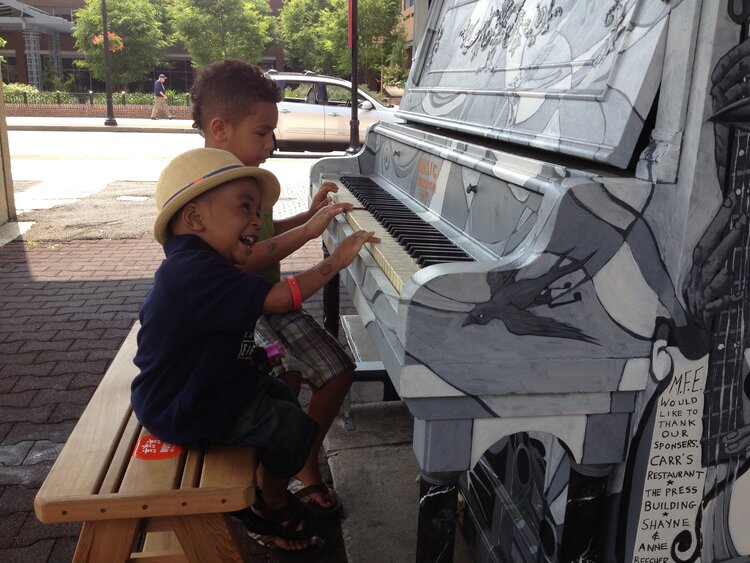
The impact of our Songs For Justice project on MFE as a whole has been transformational. It has introduced us to a much wider and more diverse community from which to draw upon as we move forward as an organization. Similar to a gumbo, the additional new and diverse people (“spices”) we’ve added to our mix has made us a much stronger and effective organization. Making the commitment to embrace and work toward a diverse and inclusive company or CBO is not about “charity”. It is about business. While that alone is enough reason to embrace diversity, there are also practical business and organizational benefits that accrue as a result of those efforts. In other words, embracing diversity is not only the right thing to do, it is also the smart thing to do.
For example, one of the things that our board has committed to is increasing diversity of the board, employees, volunteers and vendors we use. Through the new contacts we’ve made, we have been able to identify several people of color to join our board and committee structure and also have a more diverse list of vendors and subcontractors we can partner with as we move forward.
Whether as an individual, business or CBO, it is important to periodically take an unvarnished, honest look in the mirror. Such honest self-reflection can reveal uncomfortable truths about yourself or your organization. Unfortunately, we do not do that often enough. It can be quite painful when, after such honest self-examination, you find that you might not be living up to the standards and ideals you profess to believe in and act upon.
For example, we began a 360-degree review of our policies, procedures and bylaws as well as criteria and goals for strategically diversifying the organization. There is no question that these measures have made us a much better organization. But the fact is, we should have made these efforts to become more diverse long ago. While we have had POC on our board, we were not very directional and strategic regarding our diversity efforts and how that diversity could be leveraged to more effectively meet our mission. Why didn’t we? In a word, we (particularly me as executive director) were, quite frankly, lazy. I take full responsibility for that.
This is what I mean by lazy. The vast majority of children and families we serve are children and families of color. While we may not have consciously thought this, I’ve come to realize that, subconsciously, we were using that as an excuse to not feel any sense of urgency to become more diverse organizationally. We used that fact as a “free pass” on having to make a serious, top to bottom, commitment to diversity. After much reflection, self-assessment and critique we have come to the realization that precisely because we serve primarily children and families of color we should have an organization that reflects the diversity of that cohort. By not doing so, we were underperforming as it applied to fully leveraging our resources to best serve our main constituents. For an organization that is committed to serve that population, this was a painful realization. How could we think we were serving a particular cohort to the best of the organization’s ability if we did not have much organizational representation of that cohort? How can an overwhelmingly white organization think that they are most effectively serving a population consisting largely of POC without a strong presence of POC throughout the organization? In short, we were lazy. While we are proud of the work we have done, I lament the fact that we could have done more and done it more effectively had we been a more diverse organization.
That said, we are already a better, stronger and more effective organization because of the SFJ project. It’s another example of how diversity equals strength.
For example, one of my favorite MFE programs is our summer camp. Generally, we offer 2 – 3 weeks of camp, each week hosting approximately 100 children. I love this program so much that in 2019, I participated in the camp…as a camper. I was a member of the percussion section, along with four students, all of whom were no older than 12. It was a blast!
The camp is free and open to anyone, although we do target the kids who participate in our after-school programs, which consists largely of POC. But because it is free and open to the public, we attract kids of all backgrounds. The director of our MFE faculty is Dr. Michael Jamanis, a Julliard trained world class violinist. Several years ago, Michael began a career transformation as he was becoming less interested in the white dominated classical music industry and was looking for a new musical direction. The timing was serendipitous as he was looking for a more meaningful way to employ his musical talents and we were looking for someone to start our music education programming. He began going into schools and working alongside teachers and directly with students. He fell in love with working with this diverse group of students. This morphed into him creating an after-school strings program as well as a summer camp program. Along the way, he became increasingly interested in leveraging music as a tool to highlight and educate regarding issues relating to social justice.
Over the years, due to his extraordinary efforts, we have slowly built an MFE faculty, which now includes two full-time instructors as well as several independent contractors and many volunteers. As he became more involved with us, his interest in and commitment to using music as a tool to promote justice and equity continued to grow. To that end, he pushed us to join the El Sistema organization. El Sistema is a music education program founded in Venezuela in 1975 by Venezuela educator, musician and activist Jose Antonio Abreu. One of the major focuses of the organization is using music to promote social change.
We began our relationship with El Sistema before the George Floyd murder. So, in that sense, we were already on a path towards leveraging music as a social change agent. But since then, our relationship with El Sistema has taken on more urgency. And we are beginning to reap benefits as a result.
I witnessed the fruits of our efforts recently when attending the end-of-week summer camp concert. On stage the make-up of the students was extremely diverse (approximately 25% white, 10% Asian, 40% Hispanic and 25% Black). But just as important was the make-up of the faculty (50% white and 50% Black). While we still have room to improve as it applies to perfectly reflecting the children we serve, this represents significant progress as the students were able to see and take instruction from teachers and role models who are not simply white.
Here is something else that we have done as an organization that never would have occurred to us without the 360-degree evaluation of our operations and programs. We are in the process of upgrading our website to where it can be accessed and read in both English and Spanish. This is something we should have figured out and executed long ago. While the vast majority of the children we serve speak English, often their parents or guardians do not. That simple act, a result of our directed efforts to become a more inclusive and diverse, has made us more family friendly for Spanish speaking families and thus a much more effective organization.
Here’s the point. Achieving progress related to diversity did not just happen. We had, over the past several years, made some very intentional and directed decisions that, over time, resulted in a more diverse organization. We threw out a few seeds, watered them and, in time, they began to bear fruit. But it was a series of decisions and directed actions that laid the ground work for us to eventually become more diverse.
In short, It is not enough to acknowledge the need to become more diverse. That is simply the first step. Once acknowledged, the next step is to follow through with intentional and direct actions to achieve that diversity. Becoming more diverse as an organization is not simply about adding a few POC to the board. Rather, it is evaluating all aspects of your programs, services and structures from top to bottom. While change will not occur overnight, the fact is, it will never occur unless as you take directed, strategic actions, both big and small, to realize that diversity and, as a result, become more effective in meeting your mission.
While we still have a long way to go as it applies to enhancing our diversity as an organization, through the SFJ project we came to realize that making that commitment and taking specific, directed actions to become more diverse is not a sign of weakness, but a sign of organizational maturity and strength.

